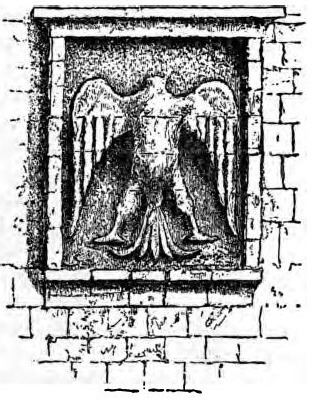 | ||
The Arab eagle, in Egypt also known as the Eagle of Saladin (Arabic: نسر صلاح الدين Nasr Ṣalāḥ ad-Dīn) or as the Republican Eagle (النسر الجمهورى an-nasr al-jumhūrá) is a heraldic eagle used as an emblem in Arab nationalism and in the coat of arms and flags of the Arab world. It is currently used as part of coat of arms of Egypt, Iraq and Palestine.
Contents
Origin of the term
The association with Saladin is due to the depiction of an eagle on the west wall of the Cairo Citadel built under Saladin, although the eagle itself is of more recent date. "The eagle in the Citadel of Cairo is of very uncertain date, probably considerably later than the period of Saladin". The eagle is headless and is assumed to have originally been a double-headed eagle. The Cairo Citatel is not its original location, it has been transferred there from an unknown location at an unknown time prior to 1670.
Note that the word نسر nisr, which may mean either "eagle" or "vulture", is used for Arab nationalism; the actual word for "eagle", عقاب ʿuqāb is reserved as the name of the Black Standard used in Jihadism.
History
While the Pan-Arab colors of the Flag of the Arab Revolt date to the early 20th century (the Arab Revolt of 1916), the eagle as a symbol of Republic of Egypt was introduced in the Egyptian revolution of 1952. The emblem was inherited by the coat of arms of the United Arab Republic of 1958, and from this time the "Arab eagle" was taken to represent wider Arab nationalism rather than Egypt in particular.
Following the 1963 Ramadan Revolution by the Arab Socialist Ba'ath Party – Iraq Region, the Arab eagle was introduced as the new coat of arms of Iraq, directly based on the design used by Gamal Abdel Nasser for the Egyptian revolution.
The Federation of Arab Republics established by Muammar Gaddafi in 1972 at first adopted a Hawk of Quraish as its emblem, but this was replaced by the Arab eagle in 1984. Conversely, the Gaddafi's Libyan Arab Republic in 1969 also adopted the eagle, but replaced it by the Hawk of Quraish in 1972.
In the Egyptian revolution of 2011, the eagle was associated with the Mubarak regime. Mehrez (2012) describes a stenciled graffiti depicting the Eagle of Saladin turned upside down as a call for the regime's downfall.
Ganzeer, an Egyptian graphics artist widely known for his revolutionary street art, explains, 'The current "Eagle of Saladin" emblem in the white band of the flag, however, wasn't used until 1984. Which means ... the current eagle on our flag belongs to Mubarak's regime.' This connection of the 'Eagle of Saladin' with the Mubarak regime provides the key to understanding this stencil piece.
